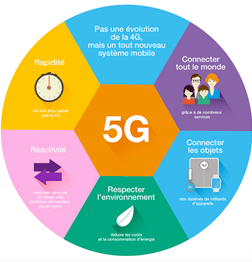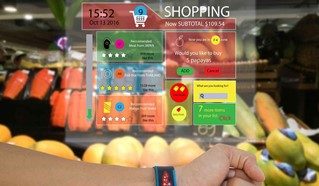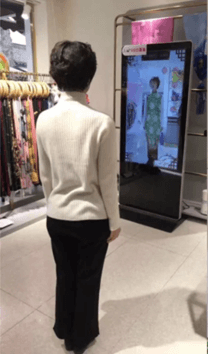A new technology that appeared in 2018 with the PyongChang Olympics, 5G only really began its implementation in 2019 in Asia and the USA. The term refers to the fifth generation of standards for mobile technology. This new generation differs from its predecessor in its much higher data transmission speed, lower latency, as well as a higher tolerance of connected devices per km² simultaneously [1].
Despite a still low penetration rate (15% for South Korea, the leader in the field), this new generation is already shaping up to be a revolution, given the technologies it supports. With this new realm of possibilities, a change in consumer behavior and ever-increasing pressure on consumer expectations is to be expected. The retail sector therefore needs to be fully prepared for this coming change.
[1] What is 5G and how does it work? - Ariase

Forrester Research recently published a study entitled "The CIO's Guide To 5G In The Retail Sector" [1]. This study looks at the impact of 5G on the retail sector, and sees this technology as the missing brick in a seamless customer journey, whether physical or digital. As well as promising a multi-sensory shopping experience and a personalized customer journey, 5G is also expected to have a beneficial impact on supply chain operations and inventory management.
Until now, many existing technologies have been impossible to implement in the retail sector, due to low bandwidth availability or high maintenance costs. 5G makes this possible and affordable.
[1] The CIO's Guide To 5G In The Retail Sector
Among the long list of technologies concerned are theIoT (Internet of Things) and Virtual or Augmented Reality. Thanks to its promise of increased throughput, 5G also serves as a foundation for artificial intelligence. Until now, many technologies have suffered from excessive latency between the physical medium and the servers on which the AI enabling their use is located.
A multi-sensorial customer experience
This high-potential technology would be essential in creating seamless omnichannel customer experiences. This type of immersive experience, blurring the boundary between physical and digital points of sale, has become a genuine consumer expectation, and 5G is the decisive step in this direction [1].
While neither 5G nor the IOT are technologies that can be considered mature today, many companies already see them as a competitive advantage. Some countries have invested heavily in this area and are encouraging their retail players to innovate using these new technologies. China, for example, is supporting the development of self-service stores that take full advantage of 5G. No-service" outlets such asAmazon 's concept store, "self check-out" stores and "showcase stores" are proliferating. While this new model is still in its infancy today, these three existing types of " self-service retail " are on an upward slope.
[1] How Technology is Changing Retail
Increase engagement with a personalized customer journey
Nowadays, it's considered a major competitive advantage to be able to quickly and accurately analyze consumer behavior and preferences. This, in turn, makes it possible to adapt just as quickly by making operational changes. Yet, according to a study by Alteryx and Retailwire of 350 retail players and brands, only 16% consider themselves experts in data collection and exploitation, while 24% describe themselves as "beginners" and 60% as "in the process of mastering" [1]. 5G fills these gaps, bringing the retail sector into the Data Age.
[1] Shopper insights: insider perspectives infographic

Thanks to its lower energy costs, 5G enables IoT devices to be used in-store [2]. This gives supermarkets access to technologies such as smart labels and other retail-enhancing sensors. This type of sensor would enable in-store signage to be personalized according to what consumers have put in their shopping baskets, thus highlighting the items most likely to match them.
The device density permitted and the low latency inherent in 5G would also open up the possibility of using facial recognition tools on the shelf. Obtaining data on the products most frequently viewed during the purchasing process would make it possible to propose a personalized digital offer even after leaving the point of sale.
[2] Meani, Claudio, et al. "Enabling smart retail through 5G services and technologies." architecture 2 (2018): 3.
Benefits for the supply chain
5G also offers a cheaper and faster long-term alternative for tracking products and inventory within the supply chain.
Previously a real brake on the development of logistics, the number of devices supported per km² increases from 4,000 to 1 million with 5G. This increase multiplies digital management opportunities in high-density areas such as warehouses and sorting centers. The quantity of information received, and the speed with which it is processed, offers greater visibility over the entire chain, from fleet to warehouse stock [1].
[1] Guo, Yanlong. "The Research of 5G Internet of Things on the Transformation of Unmanned Retail."
China: the first land of experimentation

When it comes to 5G, Asia stands out with rapid implementation, particularly in South Korea and China. Indeed, these two countries have seen 5G arrive on their territory as early as the beginning of 2019.
China was able to innovate early on thanks to an alliance between Huawei (world leader in 5G) and China Mobile (China's leading mobile operator). This alliance made it possible to explore different business models and ways of using 5G in retail.
In Shanghai's Hongqiao station, for example, new customer experiences have been imagined where robots meet travelers to welcome them, provide them with a shopping guide to the station's various stores and accompany them on their customer journey. This type of experimentation can also be found in Hangzhou, where "virtual mirrors" have been installed in the Changqing Street ready-to-wear stores. These mirrors are capable of displaying the image of the customer wearing the outfit he or she would like to try on in real time. In addition to saving the customer time, these mirrors increase interaction with the customer, thanks in particular to the ability to "push" suggestions in real time based on previous garments tried on [1].
[1] 5G Virtual Mirrors and Commerce Cloud Illuminate Hangzhou's Silk City
In terms of fully digital journeys leveraging 5G, China's Alibaba is leading the way with its Tmall e-commerce platform (ranked3rd by Alexa [1]). Tmall allows users to try on different cosmetics such as lipsticks, eyeliners or eye shadow in augmented reality, with a fidelity approaching that of a physical make-up application.
The increase in data transmission speed enabled by 5G has also prompted Tmall to launch version 2.0 of its flagship product. From now on, it is possible for companies to customize their page on the site, enabling consumers to access a personalized homepage based on their shopping habits on the site. Users' consumption patterns are analyzed in real time, and their home page adapts instantly.
[1] https://www.alexa.com/topsites
5G: a springboard for retail renewal
Today, the retail sector is at a crossroads. The process of renewal that began in the 90s is now culminating in the arrival of 5G. If other sectors, such as industry, have already taken this step, then retail needs to do so too. Innovation and the ability to adapt to this new technology will be key competitive factors. 5G could be the answer to consumers' ever-growing expectations in terms of seamless customer journeys. In this respect, 5G could well be the keystone linking the consumer and the point of sale.

